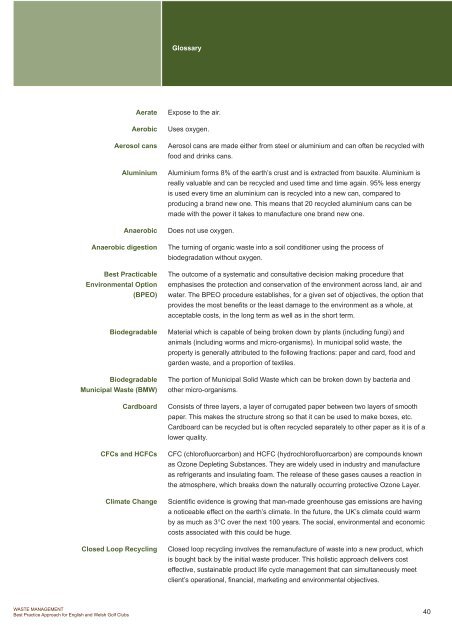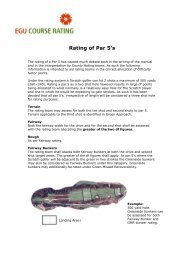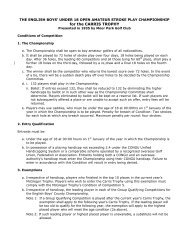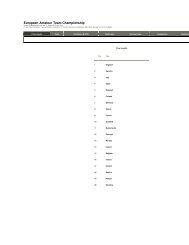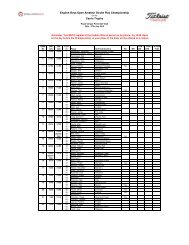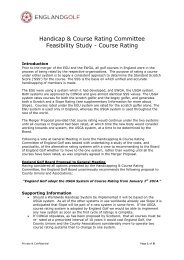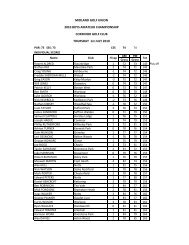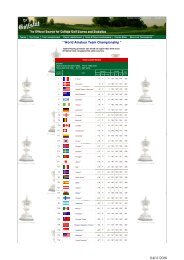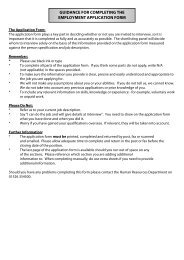Waste management - England Golf
Waste management - England Golf
Waste management - England Golf
You also want an ePaper? Increase the reach of your titles
YUMPU automatically turns print PDFs into web optimized ePapers that Google loves.
Glossary<br />
Aerate<br />
Aerobic<br />
Aerosol cans<br />
Aluminium<br />
Anaerobic<br />
Anaerobic digestion<br />
Best Practicable<br />
Environmental Option<br />
(BPEO)<br />
Biodegradable<br />
Biodegradable<br />
Municipal <strong>Waste</strong> (BMW)<br />
Cardboard<br />
CFCs and HCFCs<br />
Climate Change<br />
Closed Loop Recycling<br />
Expose to the air.<br />
Uses oxygen.<br />
Aerosol cans are made either from steel or aluminium and can often be recycled with<br />
food and drinks cans.<br />
Aluminium forms 8% of the earth’s crust and is extracted from bauxite. Aluminium is<br />
really valuable and can be recycled and used time and time again. 95% less energy<br />
is used every time an aluminium can is recycled into a new can, compared to<br />
producing a brand new one. This means that 20 recycled aluminium cans can be<br />
made with the power it takes to manufacture one brand new one.<br />
Does not use oxygen.<br />
The turning of organic waste into a soil conditioner using the process of<br />
biodegradation without oxygen.<br />
The outcome of a systematic and consultative decision making procedure that<br />
emphasises the protection and conservation of the environment across land, air and<br />
water. The BPEO procedure establishes, for a given set of objectives, the option that<br />
provides the most benefits or the least damage to the environment as a whole, at<br />
acceptable costs, in the long term as well as in the short term.<br />
Material which is capable of being broken down by plants (including fungi) and<br />
animals (including worms and micro-organisms). In municipal solid waste, the<br />
property is generally attributed to the following fractions: paper and card, food and<br />
garden waste, and a proportion of textiles.<br />
The portion of Municipal Solid <strong>Waste</strong> which can be broken down by bacteria and<br />
other micro-organisms.<br />
Consists of three layers, a layer of corrugated paper between two layers of smooth<br />
paper. This makes the structure strong so that it can be used to make boxes, etc.<br />
Cardboard can be recycled but is often recycled separately to other paper as it is of a<br />
lower quality.<br />
CFC (chlorofluorcarbon) and HCFC (hydrochlorofluorcarbon) are compounds known<br />
as Ozone Depleting Substances. They are widely used in industry and manufacture<br />
as refrigerants and insulating foam. The release of these gases causes a reaction in<br />
the atmosphere, which breaks down the naturally occurring protective Ozone Layer.<br />
Scientific evidence is growing that man-made greenhouse gas emissions are having<br />
a noticeable effect on the earth’s climate. In the future, the UK’s climate could warm<br />
by as much as 3°C over the next 100 years. The social, environmental and economic<br />
costs associated with this could be huge.<br />
Closed loop recycling involves the remanufacture of waste into a new product, which<br />
is bought back by the initial waste producer. This holistic approach delivers cost<br />
effective, sustainable product life cycle <strong>management</strong> that can simultaneously meet<br />
client’s operational, financial, marketing and environmental objectives.<br />
WASTE MANAGEMENT<br />
Best Practice Approach for English and Welsh <strong>Golf</strong> Clubs<br />
40


